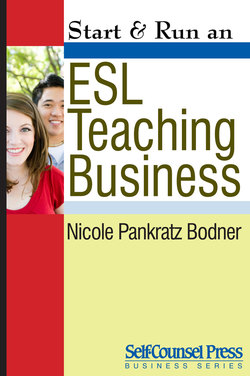Start & Run an ESL Teaching Business

Реклама. ООО «ЛитРес», ИНН: 7719571260.
Оглавление
T. Nicole Pankratz - Bodner. Start & Run an ESL Teaching Business
START & RUN AN ESL TEACHING BUSINESS
Introduction
How the Book Is Organized
How to Use This Book
Part 1. ESL Industry Overview
1. ESL Facts and Figures
International Students
Immigrants
Industry Needs and Trends in Your Area
2. ESL Business Options
Starting a Tutorial Service
Students
Programs
Locations and schedules
Tutorial fees
Starting a School
Students
Programs and courses
“English only” policy
Types of locations
Peak seasons
Tuition fees
ESL Products
English-on-the-Go
Teacher Training
ESL Services
Homestay
Which ESL Option is Right for You?
Part 2. Starting and Running an ESL Tutorial Service
3. Understanding Your Role in the ESL-Tutoring Market
Exploring Your Market
Finding a Niche Market
4. Developing Your Programs and Services
Big Picture Planning
Creating a student profile
Determining the purpose of your program through a mission statement
Clarifying your delivery method
Defining how your services fill a market niche
Outlining your programs and services
Establishing an intake and assessment system
Program and Service Options
Program options for immigrant youth
Program options for young international students
Program options for adult international students
Extracurricular program options for all ages and types of students
Organizing and Scheduling
5. Key People and Their Roles
Program Coordinator
Booking Person
Tutors
Marketer
Accommodation Coordinator
Office Staff
Activities Staff
6. Location and Facilities
7. Marketing
Word-of-Mouth Advertising
Promotional Material
Agents
Promotions
8. Policies and Procedures
9. Maintaining and Building Your Customer Base
Potential Problems That Could Become Nasty
Wasting time
Failing to deliver the goods
Too many changes and complications
Inappropriate attire
Little Things That Promote Team Spirit in Your Students
Newsletters
Contests
Get-togethers and outings
Being open to extras
Part 3. Starting and Running an ESL School
10. Exploring Your Market
Clarifying Your Market
Determining Your Target Market
Considering Which Programs Best Match Your Market
Making Your Mark
Responding to Your Market
Student needs
Student desires
Student perceptions
11. Your School, Your Programs
Big-Picture Planning
Creating a student profile
Determining the purpose of your programs (mission statement)
Clarifying your delivery method
Defining the ways in which your school fills a market niche
Developing a program overview
Establishing a system of evaluation
Program Development
Developing a course outline
Using a textbook series
Creating your own programs
Thinking about program themes
12. Services
Accommodation
Homestay
Apartment rentals
Extracurricular Activities
13. Key People and Their Roles
Director
Program Coordinator
Teachers
Marketer
Accommodation Coordinator
Office Staff
Activities Staff
14. Location and Facilities
Urban versus Rural
Location Guidelines
15. Marketing
Promotional Material
Agents
Word-of-Mouth Advertising
Promotions
16. Policies and Procedures
Common Issues Warranting a Formal Policy or Procedure
Preparing for Future Policy and Procedure Issues
17. Maintaining and Building Your Student Base
Little Problems That Can Turn into Big Problems
Cutting corners
Awkward coffee breaks and lunch breaks
Nagging
Too many holidays
Lack of take-home materials
Little Niceties That Spread Good Vibes
Prizes and gifts
Welcome Day
Excursions
School clubs
Student of the term
Parties
Part 4. Setting Up Your Business
18. Developing Your Business Plan
Executive Summary
Description of the Industry
Description of the Business
Products and Services
Marketing Plan
Operational Plan
Corporate Structure and Support
Risk Assessment and Action Plan
Finances
Appendixes
19. Assembling Your Business Team
Lawyer
Accountant
Banker
Insurance Agent or Broker
Other Individuals Worth Building Relationships With
20. Getting Started
What Type of Business Structure Should I Choose?
Sole proprietorship
Partnership
Corporation, or limited liability company (LLC)
What Should I Call My Business?
Where Should I Work?
What Kind of Registration and Licensing Do I Need for My Business?
What Equipment and Supplies Do I Need to Get My Business Up and Running?
Home-based tutorial service office
Office furniture
Office supplies
Business stationery
Communication equipment
Teaching resources
Contracts and other related business forms
A school with 20 or more students
Furniture for the office and/or reception area
Teachers’ room furniture
Office supplies
Business stationery
Classroom furniture
Furniture and equipment for student lounge and eating area
Communication equipment
Resources
Contracts and other forms
21. Planning and Organizing Your Finances
Determining Your Start-up Costs
Determining Your Ongoing Monthly Expenses
Obtaining Financing
Types of financing
Where to get financing
Keeping Financial Records
Setting and Collecting Fees
Setting fees
Collecting fees
Planning for your business expenses
Getting Contracts for Government-Funded Language Programs
22. Exploring Your Insurance Options
Types of Insurance
Industry Specific Insurance
Student health insurance
23. Handling Legal Issues
Visas
Visas for the US
Visas for Canada
Accreditation Agencies and Industry Associations
Hiring Employees
Acknowledgments
Dedication
About the Author
Other Titles in the Start & Run Series
Notice to Readers
Self-Counsel Press thanks you for purchasing this ebook
Contents
Отрывок из книги
The information in this book is based on my decade and a half of experience working in the English as a Second Language (ESL) industry.
Over the years, I have worn many hats — teacher, tutor, program coordinator, textbook writer, curriculum developer, and teacher trainer. I have worked in large cities and small towns, and in a variety of institutions, large and small, well established and just barely up and running. I have worked with students of all ages from more than 40 countries; students with visual impairment, hearing loss, or physical challenges; and students with unforgettable stories of both hardship and hope. I have worked solo and with teams of professionals, some effective and others less so.
.....
Teacher-training programs are not all created equal. Some are comprehensive university-based programs that last two years. Others run for a week and are designed to quickly prepare “teachers” for work overseas at English institutes. Still others are offered online, allowing prospective teachers to work at their own pace, even in remote places.
There are three main teacher-training courses:
.....